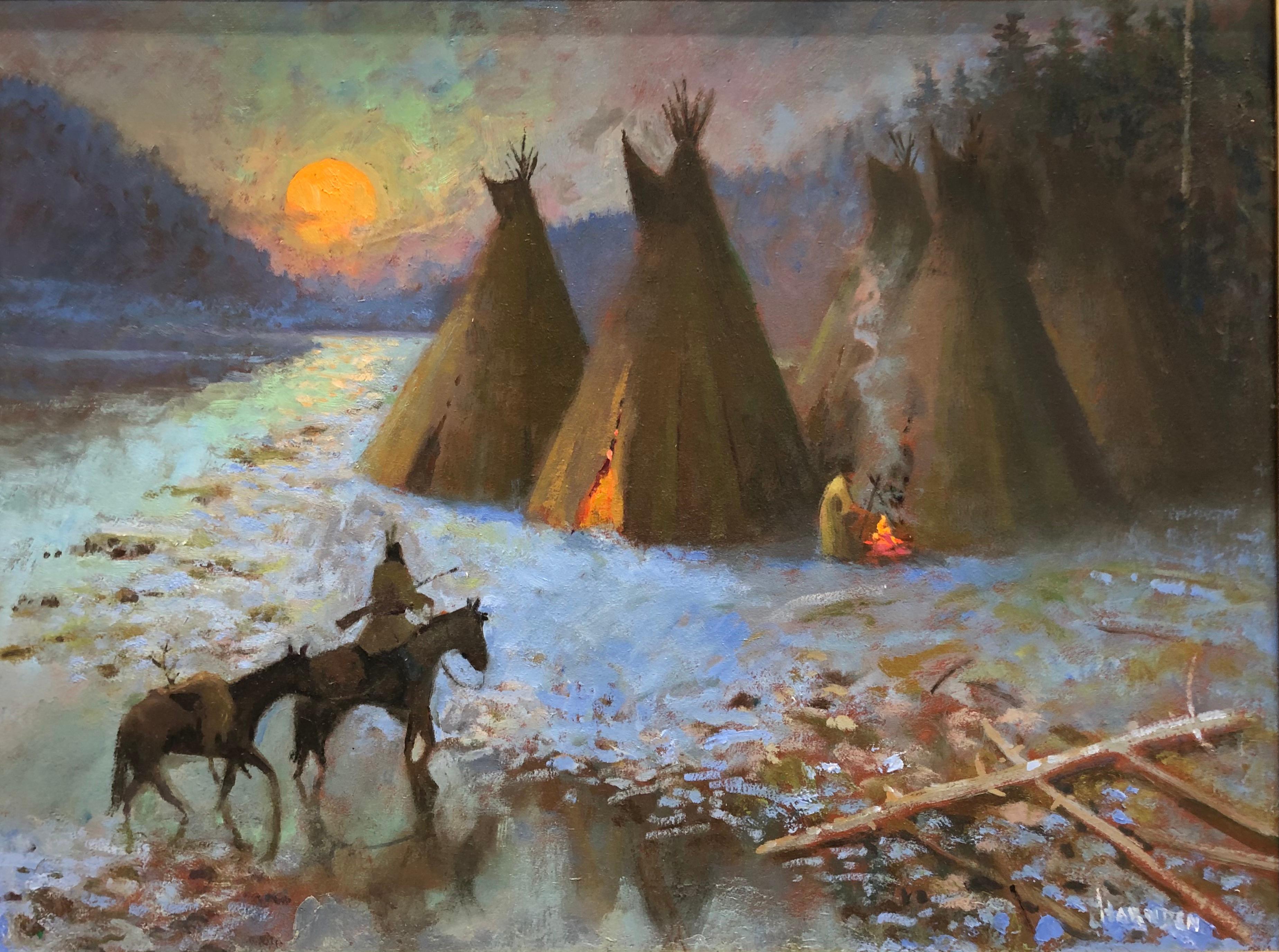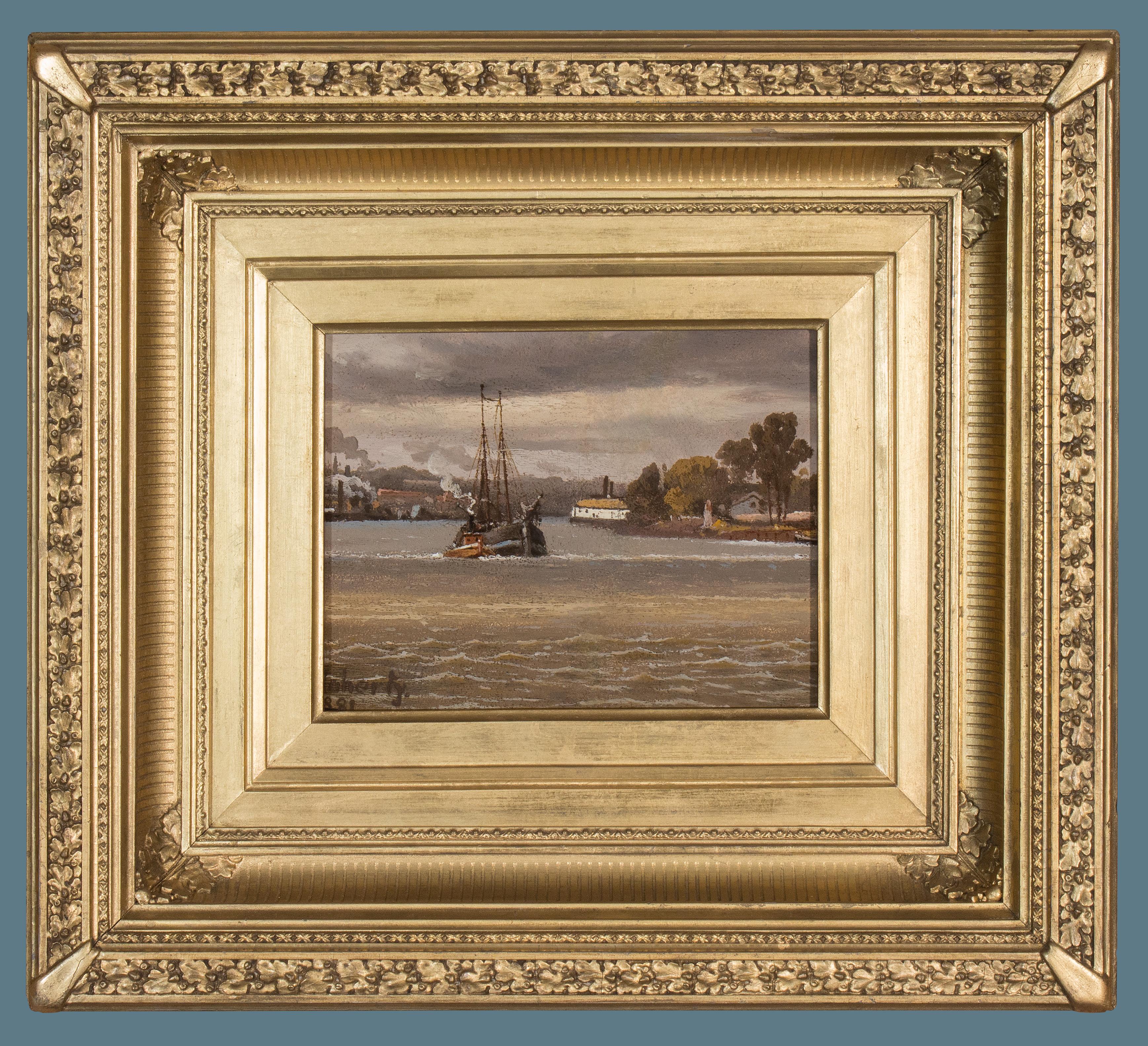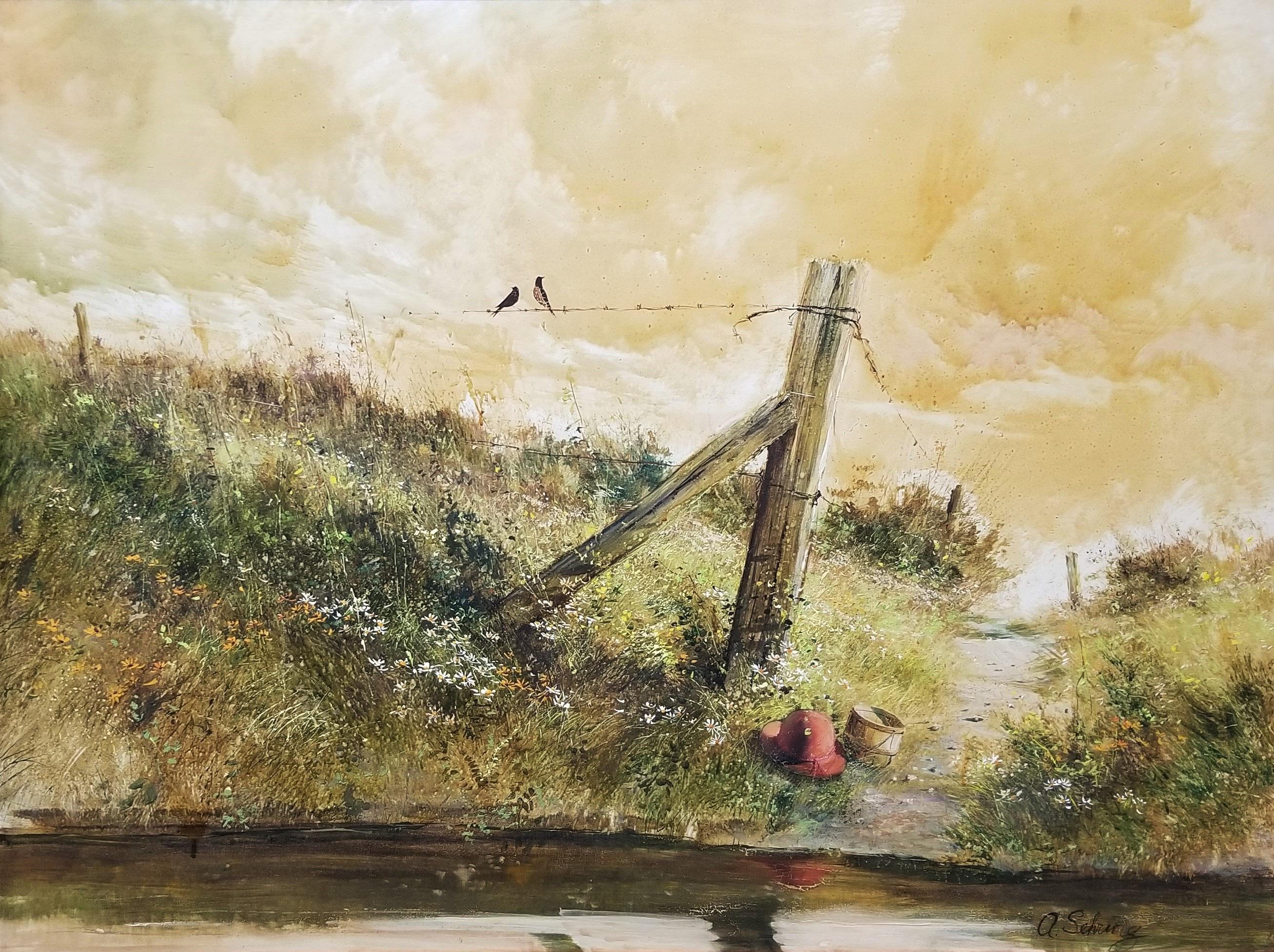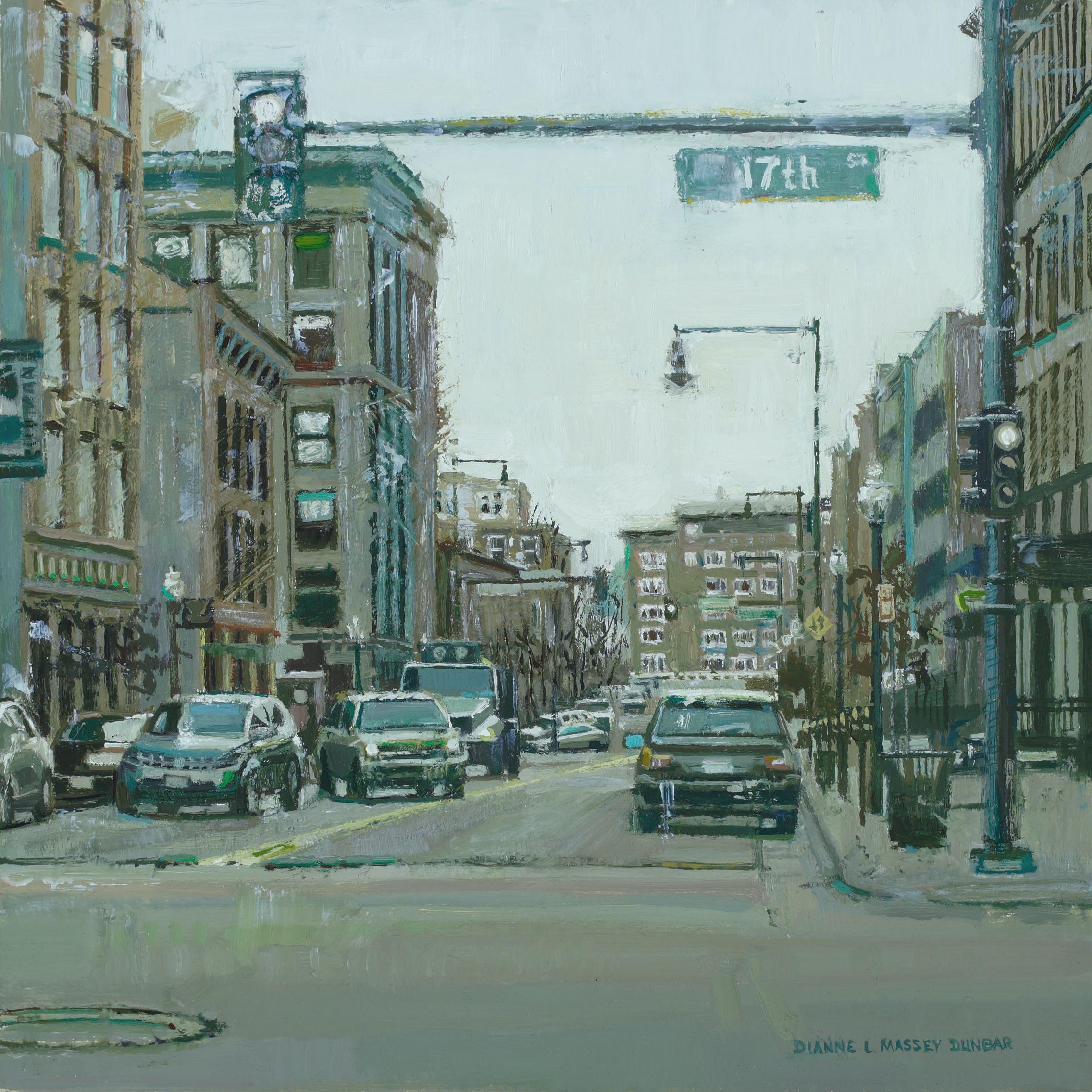Items Similar to Blue Horizon (near Sante Fe, New Mexico)
Want more images or videos?
Request additional images or videos from the seller
1 of 8
Elmer Ladislaw NovotnyBlue Horizon (near Sante Fe, New Mexico)
About the Item
Blue Horizon (Near Sante Fe, New Mexico)
Signed by the artist lower right (see photo)
Oil on board, 16 x 27 5/8 inches
Condition: Very good. Housed in the original frame from the artist
Elmer Novotny (1909-1997)
Education:
Slade School University of London, England (1930/31)
Academy of Art, Zagreb, Yugoslavia (1930/31)
Yale University, School of Art
Cleveland School of Art, Industrial Camouflage, 1943
Award:
Cleveland Museum of Art, Cleveland, Ohio (prizes, 1930, 1937, 1938)
Butler Institute of American Art, Youngstown, Ohio
Akron Art Museum, Akron, Ohio
Canton Art Institute, Canton, Ohio (Prizes 1944, 1945, 1946)
One of one hundred artists in the US, “Directions in American Painting”, Carnegie Museum, Pittsburgh, 1940
Special National Invitational Exhibition “Kearney Memorial Ex.,” 1952
Special Invitational, “Cleveland’s Fabulous Fifty,” NYC 1965
Special Invitational, “12 Selected Cleveland Artists,” 1970
Invited Artist, Butler Institute of Art, 1978 National Show
PERMANENT COLLECTIONS:
Akron Art Museum, Akron, Ohio
Butler Institute of American Art, Youngstown, Ohio
Canton Art Institute, Canton, Ohio
Carnegie Museum, Oxnard, CA
Cleveland Museum of Art, Cleveland, Ohio
Cleveland Municipal Collection, Cleveland, Ohio
Cleveland Historical Society, Cleveland, Ohio
Cleveland Artist’s Foundation, Cleveland, Ohio
Cleveland Institute of Art, Cleveland, Ohio
Samuel Hahn Art Museum of the University of Florida, Gainsville, FL
The James A. Michener Collection
Johnson-Humrickhouse Museum
Northeast Ohio Museum of Art
USA Government Collection
- Creator:Elmer Ladislaw Novotny (1909, American)
- Dimensions:Height: 16 in (40.64 cm)Width: 27.63 in (70.19 cm)
- Medium:
- Movement & Style:
- Period:
- Condition:Original condition, in original frame with linen liner.
- Gallery Location:Fairlawn, OH
- Reference Number:
About the Seller
5.0
Recognized Seller
These prestigious sellers are industry leaders and represent the highest echelon for item quality and design.
Platinum Seller
These expertly vetted sellers are 1stDibs' most experienced sellers and are rated highest by our customers.
Established in 1978
1stDibs seller since 2013
711 sales on 1stDibs
Typical response time: 1 hour
Associations
International Fine Print Dealers Association
- ShippingRetrieving quote...Ships From: Fairlawn , OH
- Return PolicyA return for this item may be initiated within 10 days of delivery.
More From This SellerView All
- Long Light Notre DameBy Robert HallowellLocated in Fairlawn, OHLong Light Notre Dame Oil on canvas, 1931 Note: the painting is NOT framed Signed and dated lower right Condition: Excellent Conservation by Monica Radecki, South Bend Canvas size: ...Category
1930s American Impressionist Landscape Paintings
MaterialsOil
- South Hampton 8:45PMBy Cleve GrayLocated in Fairlawn, OHSouthhampton 8:45 PM Signed Gray lower right Titled on verso in black paint Oil on canvas, 28 x 40 inches Exhibited: Jacques Seligman Galleries (label) twice, original price $450. (See photo) Condition: {Small slit in canvas, delivered to Monica for cleaning and repair} Expertly repaired by Monica Radecki Gray had his first one man show at Seligmann in 1947. NY Times Obit: Large Abstract Works, Dies By Ken Johnson Dec. 10, 2004 Cleve Gray, a painter admired for his large-scale, vividly colorful and lyrically gestural abstract compositions, died on Wednesday in Hartford. He was 86. The cause was a massive subdural hematoma suffered after he fell on ice and hit his head on Tuesday outside his home in Warren, Conn., said his wife, the writer Francine du Plessix Gray. Mr. Gray achieved his greatest critical recognition in the late 1960's and 70's after working for many years in a comparatively conservative late-Cubist style. Inspired in the 60's by artists like Jackson Pollock, Clyfford Still, Mark Rothko and Helen Frankenthaler, Mr. Gray began to produce large paintings using a variety of application methods -- pouring, staining, sponging and other nontraditional techniques -- to create compositions combining expanses of pure color and spontaneous calligraphic gestures. In 1972 and 73 he produced "Threnody," a suite of 14 paintings, each measuring 20 feet by 20 feet, dedicated to the dead on both sides in the Vietnam War. The series was commissioned by the Neuberger Museum of Art at Purchase College, part of the State University of New York, and is considered one of the largest groups of abstract paintings created for a specific public space. PUBLIC COLLECTIONS: Addison Gallery of American Art, Phillips Academy, Andover, MA Albright-Knox Art Gallery, Buffalo, NY The Brooklyn Museum, Brooklyn, NY Cathedral of Saint John the Divine Art Gallery, New York, NY Colby College Museum of Art, Waterville, ME Columbia University Art Gallery, New York, NY Columbus Museum of Art, Columbus, OH The Corcoran Gallery of Art, Washington, D.C. Grey Art Gallery and Study Center, New York University, New York, NY Solomon R. Guggenheim Museum, New York, NY Heckscher Museum, Huntington, New York, NY Honolulu Academy of the Arts, Honolulu, HI The Jewish Museum, New York, NY Krannert Art Museum, University of Illinois, Champaign, IL Mattatuck Museum, Waterbury, CT The Metropolitan Museum of Art, New York, NY Minnesota Museum of Art, St. Paul, MI Museum of Art, Rhode Island School of Design, Providence, RI Museum of Fine Arts, Boston, MA Museum of Fine Arts, Houston, TX The Museum of Modern Art, New York, NY National Museum of American Art, Smithsonian Institution, Washington, D.C. The Neuberger Museum, State University of New York, Purchase, NY New Britain Museum of American Art, New Britain, CT The Newark Museum, Newark, NJ Norton Gallery of Art, West Palm Beach, FL Oklahoma City Art Center, Oklahoma City, OK The Phillips Collection, Washington, D.C. The Art Museum, Princeton University, Princeton, NJ Rose Art Museum, Brandeis University, Waltham, MA Shearson Lehman Hutton Collection...Category
1950s Abstract Landscape Paintings
MaterialsOil
- Park Scene (Chelsea, Manhattan)By Virginia DehnLocated in Fairlawn, OHPark Scene (Chelsea, Manhattan) Oil on artist's board, c. 1947-49 Signed lower right (see photo) Provenance: Estate of the artist Dehn Heirs Condition: Good, needs a light cleaning Original wormy chestnut frame Painting size: 9 1/4 x 12 inches Frame size: 14 1/4 x 17 inches One of the earliest know Virginia Dehn paintings after her marriage to Adolf in 1947. The lived in Chelsea at 433 West 21st St. Inscription by artist verso: Virginia Dehn 443 W. 21 St. New York City V.70 Virginia Dehn From Wikipedia, the free encyclopedia Virginia Dehn Virginia Dehn in her studio in Santa Fe Virginia Dehn (née Engleman) (October 26, 1922 – July 28, 2005) was an American painter and printmaker. Her work was known for its interpretation of natural themes in almost abstract forms. She exhibited in shows and galleries throughout the U.S. Her paintings are included in many public collections. Life Dehn was born in Nevada, Missouri on October 26, 1922.] Raised in Hamden, Connecticut, she studied at Stephens College in Columbia, Missouri before moving to New York City. She met the artist Adolf Dehn while working at the Art Students League. They married in November 1947. The two artists worked side by side for many years, part of a group of artists who influenced the history of 20th century American art. Their Chelsea brownstone was a place where artists, writers, and intellectuals often gathered. Early career Virginia Dehn studied art at Stephens College in Missouri before continuing her art education at the Traphagen School of Design, and, later, the Art Students League, both located in New York City. In the mid-1940s while working at the Associated American Artists gallery, she met lithographer and watercolorist Adolf Dehn. Adolf was older than Virginia, and he already enjoyed a successful career as an artist. The two were married in 1947 in a private ceremony at Virginia's parents house in Wallingford, Connecticut. Virginia and Adolf Dehn The Dehns lived in a Chelsea brownstone on West 21st Street where they worked side by side. They often hosted gatherings of other influential artists and intellectuals of the 20th century. Among their closest friends were sculptor Federico Castellón and his wife Hilda; writer Sidney Alexander and his wife Frances; artists Sally and Milton Avery; Ferol and Bill Smith, also an artist; and Lily and Georges Schreiber, an artist and writer. Bob Steed and his wife Gittel, an anthropologist, were also good friends of the Dehns. According to friend Gretchen Marple Pracht, "Virginia was a glamorous and sophisticated hostess who welcomed visitors to their home and always invited a diverse crowd of guests..." Despite their active social life, the two were disciplined artists, working at their easels nearly daily and taking Saturdays to visit galleries and view new work. The Dehns made annual trips to France to work on lithographs at the Atelier Desjobert in Paris. Virginia used a bamboo pen to draw directly on the stone for her lithographs, which often depicted trees or still lifes. The Dehns' other travels included visits to Key West, Colorado, Mexico, and countries such as Greece, Haiti, Afghanistan, and India. Dehn's style of art differend greatly from that of her husband, though the two sometimes exhibited together. A friend of the couple remarked, "Adolf paints landscapes; Virginia paints inscapes." Virginia Dehn generally painted an interior vision based on her feelings for a subject, rather than a literal rendition of it.] Many of her paintings consist of several layers, with earlier layers showing through. She found inspiration in the Abstract Expressionism movement that dominated the New York and Paris art scenes in the 1950s. Some of her favorite artists included Adolf Gottileb, Rothko, William Baziotes, Pomodoro, and Antonio Tapies. Dehn most often worked with bold, vibrant colors in large formats. Her subjects were not literal, but intuitive. She learned new techniques of lithography from her husband Adolf, and did her own prints. Texture was very important to her in her work. Her art was influenced by a variety of sources. In the late 1960s she came across a book that included photographs of organic patterns of life as revealed under a microscope. These images inspired her to change the direction of some of her paintings. Other influences on Dehn's art came from ancient and traditional arts of various cultures throughout the world, including Persian miniatures, illuminated manuscripts, Dutch still life painting, Asian art, ancient Egyptian artifacts...Category
1940s American Modern Landscape Paintings
MaterialsOil
- Untitled (also known as "1811 THE BACKWOODSMAN'S CHRISTMAS")Located in Fairlawn, OHUntitled (also known as "1811 THE BACKWOODSMAN'S CHRISTMAS") Oil on canvas, c. 1875-1925 Unsigned Provenance: Found in Ohio A charming American naive no...Category
1870s Outsider Art Landscape Paintings
MaterialsOil
- Ponte Vecchio FlorenceBy Robert HallowellLocated in Fairlawn, OHPonte Vecchio Florence Oil on canvas, 1927 Signed and dated lower right corner Titled upper left NOTE: this offering is UNFRAMED Condition: Excellent Conservation by Monica Radecki, ...Category
1920s American Impressionist Landscape Paintings
MaterialsOil
- Jersey Shore IIIBy Adolf Arthur DehnLocated in Fairlawn, OHJersey Shore III Casein on Masonite, 1967 Signed lower right (see photo) Initialed, dated and titled verso Provenance: Estate of the artist Virginia Dehn (the artist's widow) Dehn Quests Created on location on the Jersey Shore. The Jersey Shore was the main playground for thousand to escape the summer heat of New York. This small painting shows Dehn's mastery of patterning color to depict movement and recreation. Part of a suite of paintings done on this theme. Within a year of it's creation, Dehn dies from a heart attack. Casein on Masonite Condition: Excellent Image: 6 x 11" Frame: 9 3/8 x 14 1/2" Adolf Dehn, American Watercolorist and Printmaker, 1895-1968 Adolf Dehn was an artist who achieved extraordinary artistic heights, but in a very particular artistic sphere—not so much in oil painting as in watercolor and lithography. Long recognized as a master by serious print collectors, he is gradually gaining recognition as a notable and influential figure in the overall history of American art. In the 19th century, with the invention of the rotary press, which made possible enormous print runs, and the development of the popular, mass-market magazines, newspaper and magazine illustration developed into an artistic realm of its own, often surprisingly divorced from the world of museums and art exhibitions, and today remains surprisingly overlooked by most art historians. Dehn in many regards was an outgrowth of this world, although in an unusual way, since as a young man he produced most of his illustrative work not for popular magazines, such as The Saturday Evening Post, but rather for radical journals, such as The Masses or The Liberator, or artistic “little magazines” such as The Dial. This background established the foundation of his outlook, and led later to his unique and distinctive contribution to American graphic art. If there’s a distinctive quality to his work, it was his skill in introducing unusual tonal and textural effects into his work, particularly in printmaking but also in watercolor. Jackson Pollock seems to have been one of many notable artists who were influenced by his techniques. Early Years, 1895-1922 For an artist largely remembered for scenes of Vienna and Paris, Adolf Dehn’s background was a surprising one. Born in Waterville, Minnesota, on November 22, 1895, Dehn was the descendent of farmers who had emigrated from Germany and homesteaded in the region, initially in a one-room log cabin with a dirt floor. Adolf’s father, Arthur Clark Dehn, was a hunter and trapper who took pride that he had no boss but himself, and who had little use for art. Indeed, during Adolf’s boyhood the walls of his bedroom and the space under his bed were filled with the pelts of mink, muskrats and skunks that his father had killed, skinned and stretched on drying boards. It was Adolf’s mother, Emilie Haas Dehn, a faithful member of the German Lutheran Evangelical Church, who encouraged his interest in art, which became apparent early in childhood. Both parents were ardent socialists, and supporters of Eugene Debs. In many ways Dehn’s later artistic achievement was clearly a reaction against the grinding rural poverty of his childhood. After graduating from high school in 1914 at the age of 19—an age not unusual in farming communities at the time, where school attendance was often irregular—Dehn attended the Minneapolis School of Art from 1914 to 1917, whose character followed strongly reflected that of its director, Munich-trained Robert Kohler, an artistic conservative but a social radical. There Dehn joined a group of students who went on to nationally significant careers, including Wanda Gag (later author of best-selling children’s books); John Flanagan (a sculptor notable for his use of direct carving) Harry Gottlieb (a notable social realist and member of the Woodstock Art Colony), Elizabeth Olds (a printmaker and administrator for the WPA), Arnold Blanch (landscape, still-life and figure painter, and member of the Woodstock group), Lucille Lunquist, later Lucille Blanch (also a gifted painter and founder of the Woodstock art colony), and Johan Egilrud (who stayed in Minneapolis and became a journalist and poet). Adolf became particularly close to Wanda Gag (1893-1946), with whom he established an intense but platonic relationship. Two years older than he, Gag was the daughter of a Bohemian artist and decorator, Anton Gag, who had died in 1908. After her husband died, Wanda’s mother, Lizzi Gag, became a helpless invalid, so Wanda was entrusted with the task of raising and financially supporting her six younger siblings. This endowed her with toughness and an independent streak, but nonetheless, when she met Dehn, Wanda was Victorian and conventional in her artistic taste and social values. Dehn was more socially radical, and introduced her to radical ideas about politics and free love, as well as to socialist publications such as The Masses and The Appeal to Reason. Never very interested in oil painting, in Minneapolis Dehn focused on caricature and illustration--often of a humorous or politically radical character. In 1917 both Dehn and Wanda won scholarships to attend the Art Students League, and consequently, in the fall of that year both moved to New York. Dehn’s art education, however, ended in the summer of 1918, shortly after the United States entered World War I, when he was drafted to serve in the U. S. Army. Unwilling to fight, he applied for status as a conscientious objector, but was first imprisoned, then segregated in semi-imprisonment with other Pacifists, until the war ended. The abuse he suffered at this time may well explain his later withdrawal from taking political stands or making art of an overtly political nature. After his release from the army, Dehn returned to New York where he fell under the spell of the radical cartoonist Boardman Robinson and produced his first lithographs. He also finally consummated his sexual relationship with Wanda Gag. The Years in Europe: 1922-1929 In September of 1921, however, he abruptly departed for Europe, arriving in Paris and then moving on to Vienna. There in the winter of 1922 he fell in love with a Russian dancer, Mura Zipperovitch, ending his seven-year relationship with Wanda Gag. He and Mura were married in 1926. It was also in Vienna that he produced his first notable artistic work. Influenced by European artists such as Jules Pascin and Georg Grosz, Dehn began producing drawings of people in cafes, streets, and parks, which while mostly executed in his studio, were based on spontaneous life studies and have an expressive, sometimes almost childishly wandering quality of line. The mixture of sophistication and naiveté in these drawings was new to American audiences, as was the raciness of their subject matter, which often featured pleasure-seekers, prostitutes or scenes of sexual dalliance, presented with a strong element of caricature. Some of these drawings contain an element of social criticism, reminiscent of that found in the work of George Grosz, although Dehn’s work tended to focus on humorous commentary rather than savagely attacking his subjects or making a partisan political statement. Many Americans, including some who had originally been supporters of Dehn such as Boardman Robinson, were shocked by these European drawings, although George Grocz (who became a friend of the artist in this period) admired them, and recognized that Dehn could also bring a new vision to America subject matter. As he told Dehn: “You will do things in America which haven’t been done, which need to be done, which only you can do—as far at least as I know America.” A key factor in Dehn’s artistic evolution at this time was his association with Scofield Thayer, the publisher of the most notable modernist art and poetry magazine...Category
1960s American Modern Landscape Paintings
MaterialsOil
You May Also Like
- Coming Home at SunsetBy William HarndenLocated in Greenville, DEVery well executed work by American artist William Harnden who specialized in Native American subjects. 23 3/4 x 29 1/2 in excellent condition frame.Category
Mid-20th Century Realist Landscape Paintings
MaterialsOil, Board
- Sailboats and Sailing Ship in Seascape early 20th Century Oil Painting FramedLocated in Stockholm, SEThis artwork showcases the beauty of sailing boats and ships sailing gracefully on the sea waters. The artist's attention to detail is evident in the intricate depiction of the ships...Category
Early 20th Century Realist Landscape Paintings
MaterialsWood, Oil, Cardboard
- View on the Delaware River Opposite PhiladelphiaLocated in Philadelphia, PAJAMES THORP FLAHERTY (American, 1836 1904) On the Delaware Opposite Philadelphia Oil on canvas, 5 3/4 x 7 3/8 inches Framed: 14 x 16 inches (approx.) Signed and dated at lower left: ...Category
1880s Realist Landscape Paintings
MaterialsBoard, Oil
- Forgotten Fence /// Realism Landscape Country Farm River Painting American ArtBy Adolf SehringLocated in Saint Augustine, FLArtist: Adolf Sehring (Russian/German-American, 1930-2015) Title: "Forgotten Fence" *Signed by Sehring lower right Circa: 1970 Medium: Original Oil Paint...Category
1970s Realist Landscape Paintings
MaterialsPaint, Oil, Board, Panel, Wood Panel
- "Cityscape in Yellow", Oil PaintingLocated in Denver, CODianne L. Massey Dunbar's (US based) "Cityscape in Yellow" is an oil painting that depicts a busy city street lined with cars and buildings, all cast in a warm yellow light. About...Category
2010s Realist Figurative Paintings
MaterialsBoard, Oil
- "Cityscape in Green", Oil PaintingLocated in Denver, CODianne L. Massey Dunbar's (US based) "Cityscape in Green" is an oil painting that depicts a busy city street lined with cars and buildings, all cast in a cool greenish blue light. ...Category
2010s Realist Figurative Paintings
MaterialsBoard, Oil





